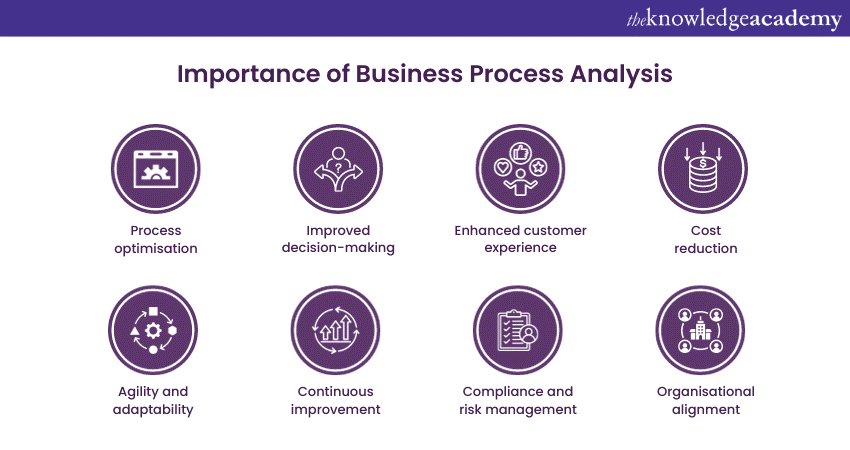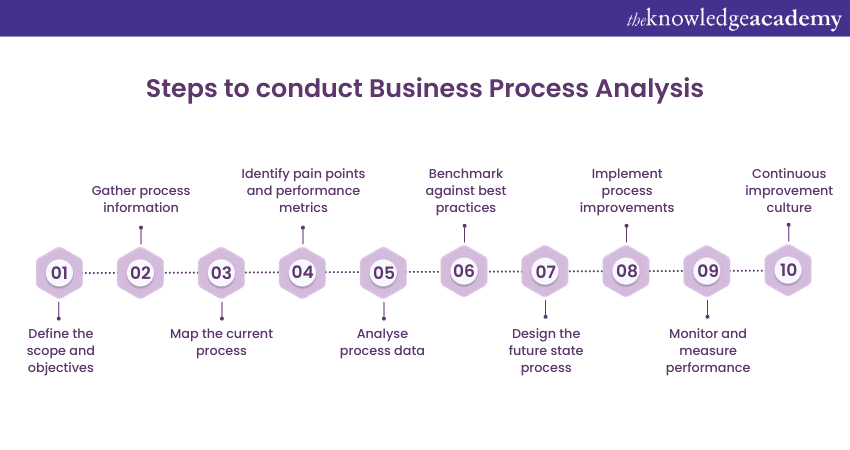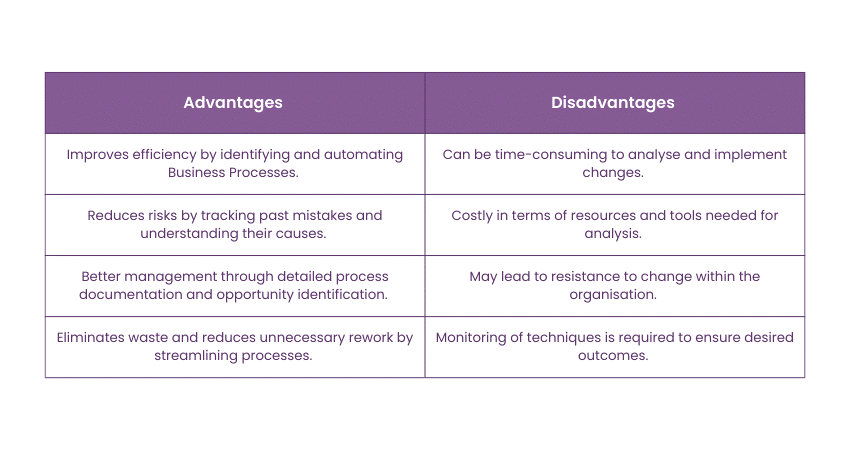We may not have the course you’re looking for. If you enquire or give us a call on +1 7204454674 and speak to our training experts, we may still be able to help with your training requirements.
Training Outcomes Within Your Budget!
We ensure quality, budget-alignment, and timely delivery by our expert instructors.

In modern business, where competition is as sharp as ever, organisations are on a quest for the golden trifecta: efficiency, effectiveness, and perpetual evolution. Enter Business Process Analysis: BPA is a practice and an art of dissecting and evaluating business operations with a fine-tooth comb, revealing golden opportunities for optimisation, streamlining, and elevating performance to new heights.
Furthermore, Business Process Analysis equips organisations with deep insights, empowering them to make strategic decisions, ignite innovation, and adapt to market changes. It involves systematically examining and evaluating Business Processes to identify opportunities for optimisation, streamlining, and enhancing.
Learn how Business Process Analysis identifies opportunities for optimisation and equips businesses with the insights needed to thrive in a competitive market.
Table of Contents
1) Understanding What is Business Process Analysis (BAP)?
2) Importance of Business Process Analysis
3) Steps to conduct Business Process Analysis
4) Techniques for Business Process Analysis
5) Methods of Business Process Analysis
6) When should the Business Process Analysis be implemented?
7) Challenges of Business Process Analysis
8) Who is responsible for Business Process Analysis?
9) BPA and automation
10) How can small and medium-sized businesses (SMEs) use BPA?
11) Conclusion
Understanding What is Business Process Analysis (BPA)?
Business Process Analysis is a systematic approach to examining your company’s workflows. These workflows consist of repetitive tasks that aim to achieve specific outcomes, such as onboarding new employees or evaluating quarterly objectives. BPA also extends to more comprehensive organisational procedures like those used in strategic planning.
As a subset of Business Process Management (BPM), BPA involves scrutinising and assessing your current processes to ensure they are still serving their intended purpose efficiently. A Business Analyst typically conducts this analysis to decide whether to maintain the status quo or to implement necessary modifications for improvement.
Business Process Analysis vs. Business Analysis
Business Process Analysis and Business Analysis differ greatly from each other when it comes to their scope and focus. Business Analysis delves into areas such as organisational structure, stakeholder requirements, technology, and strategic goals to provide a holistic view for informed decision-making. BPA is relatively simple, focusing solely on the processes. However, Business Analysis is much more detailed and focuses on all aspects of your business. Let’s consider a practical example to better understand their differences:
Let’s say you want to refine your organisation's financial tracking process; it would be ideal to use BPA. A Business Process Analyst is much more suited to managing budgets, purchasing, and monitoring revenues. However, if you want to examine your business's profitability, it makes sense to use Business Analysis techniques, as they can help you manage the broader financial landscape.
Get ready for your interview with our top business analyst interview questions.
Importance of Business Process Analysis
In this section, we will explore the importance of Business Process Analysis:

a) Process optimisation: BPA aids in pinpointing and rectifying inefficiencies and redundancies in business workflows. Streamlining these processes not only trims down unnecessary steps and shortens process durations but also boosts productivity, cuts costs, and heightens customer satisfaction.
b) Enhanced decision-making: BPA equips organisations with deep insights into their operational workflows, facilitating informed decision-making. With a clear grasp of the sequence of operations and interdependencies, organisations can make strategic choices, efficiently allocate resources, and foster innovation.
c) Superior Customer Experience: BPA allows organisations to tailor their processes to meet customer expectations better. Analysing customer interaction points reveals areas for enhancement, leading to a more seamless customer experience, fewer mistakes, and faster service, thereby bolstering customer contentment and loyalty.
d) Cost efficiency: Through BPA, organisations can identify and eliminate wasteful activities, leading to significant cost reductions. This process also promotes optimal resource use, workforce efficiency, and better technology deployment, culminating in improved financial outcomes.
e) Agility and flexibility: BPA empowers organisations to swiftly adapt to changes in the business landscape. By thoroughly understanding their processes, organisations can quickly adjust to market shifts or regulatory demands, ensuring they remain competitive and proactive.
f) Ongoing improvement: BPA serves as a driving force for perpetual enhancement within organisations. Regular process evaluation helps spot trends, measure performance, and instigate necessary changes, nurturing an environment where continuous improvement is valued and innovation thrives.
g) Compliance and risk management: BPA is instrumental in helping organisations adhere to industry norms and manage risks. Organisations can establish strong internal safeguards, evaluate potential threats, and devise effective risk mitigation tactics by delineating processes and pinpointing control points.
h) Organisational cohesion: BPA fosters unity and cooperation across different organisational departments. Engaging stakeholders from diverse areas breaks down barriers and cultivates a unified approach to understanding and managing business processes, which enhances overall organisational efficacy.Interested in Business Analysis? Try our BCS Practitioner Certificate In Requirements Engineering!
Interested in Business analysis? Try our BCS Certificate in Requirements Engineering Course!
Steps to conduct Business Process Analysis
BPA is a systematic and data-driven approach to assessing and improving Business Processes within an organisation. Follow these essential steps to conduct a successful BPA:

1) Examine how your procedures fit into the overall picture
All your operational procedures should ultimately align with broader objectives and the overarching business mission. These procedures essentially define the "how" in your business operations, serving as the means to attain our goals. However, they should always be intertwined with the "why." For instance, if your organisation's vision is to enhance global healthcare accessibility, every process you establish should contribute to this vision. It should answer why a goal has been set, and Steps to conduct Business Process Analysis.
The initial phase of your BPA involves evaluating current procedures and assessing their integration within workflows, departments, and, most importantly, the long-term objectives that uphold your company's overarching mission.
2) Get knowledge of current events
This stage involves collecting data. Before delving into Business Process Analysis, it's crucial to comprehend precisely how these processes operate. The most effective approach is to engage with those who use these processes extensively. Conduct interviews with key stakeholders, develop surveys, and scrutinise relevant Key Performance Indicators (KPIs) and metrics. Although this step may demand more time compared to others, it's essential to understand the process comprehensively before initiating any modifications.
For instance, you should interview the developers responsible for this task when examining how your product team manages and prioritises their product backlogs. Additionally, assess the Key Performance Indicators related to existing processes, such as the number of items that remain in the backlog after completing an Agile sprint.
Explore the intricacies of business process analysis for streamlined operations and improved efficiency.
3) Analyse and map your data
Now, it's time to proceed with the analysis phase. During this stage, you'll need to consolidate all of your gathered data, which should encompass:
a) Documenting each step involved in the processes under examination.
b) If available, include any process diagrams that illustrate the workflows.
c) Identifying and listing the team members involved in these processes.
d) Compiling the existing success metrics and Key Performance Indicators that measure the effectiveness of these processes.
To facilitate this analysis, you can employ business process mapping techniques. These techniques entail creating visual representations, like flowcharts or other diagrams, that lay out your processes' current sequences and steps. These visual layouts simplify comprehending and evaluating the processes, aiding in identifying patterns and gaps within the process flow.
4) Identify areas for improvement
During the analysis phase, the focus is on pinpointing redundancies and gaps within the processes, as these are key areas ripe for improvement. For instance, consider a scenario where your analysis reveals that developers are dedicating three days to plan a sprint backlog. After conducting interviews with stakeholders and examining meeting schedules, it becomes evident that time zone differences are causing this delay. In such a case, exploring new technological solutions that facilitate asynchronous communication can streamline team collaboration and significantly reduce the time spent on communication tasks. This highlights how identifying and addressing these issues can lead to more efficient processes
5) Make adjustments for business growth
Business Process Improvement (BPI) is the phase where you implement your insights. Following the Business Process Analysis, BPI initiatives modify and enhance processes, primarily aimed at boosting profitability.
The BPA serves as an exploration guide, providing a comprehensive understanding of your business procedures. The ultimate step involves harnessing this wealth of information to implement alterations that enhance existing processes or enable the creation of entirely new ones. It's the practical application of knowledge gained through analysis to achieve more efficient and effective business operations.
Dive into the Detailed Case Study of Business Analysis
Techniques for Business Process Analysis
BPA involves using various tools and techniques to analyse and improve Business Processes. Here are some commonly used tools and techniques in BPA:
a) Process mapping: Process mapping tools, such as flowcharts, and value stream maps, visually represent the sequence of activities, decision points, and interactions within a process. These visual representations help stakeholders understand the process flow and identify areas for improvement.
b) Data collection and analysis: Data collection methods, such as surveys, interviews, and observation, are used to gather information about the process. Data Analysis techniques, including Statistical Analysis and process mining, help uncover patterns, trends, and bottlenecks.
c) Benchmarking: Benchmarking involves comparing the organisation's processes against industry best practices or competitors' processes. This Business Analysis Technique helps identify performance gaps and areas for improvement.
d) Root Cause Analysis: Root Cause Analysis techniques, such as the 5 Whys and fishbone diagrams, identify the underlying causes of process inefficiencies or problems. This helps address the root causes and prevent the recurrence of issues.
e) Simulation and modelling: Simulation and modelling tools enable organisations to create virtual models of processes and test different scenarios to evaluate their impact on process performance. These Business Analysis Tools help simulate process changes before implementation, reducing the risk associated with process improvement initiatives.
g) Workflow automation: Workflow automation tools automate manual tasks, streamline approvals, and enforce process compliance. These tools improve process efficiency, reduce errors, and enhance overall productivity.
h) Process documentation software: Process documentation software, such as process modelling tools or Business Process Management (BPM) systems, helps organisations document, manage, and communicate their processes effectively.
Learn about business finance with BCS Foundation Certificate in Organisational Behaviour Training!
Methods of Business Process Analysis
BPA is guided by two major philosophies: the Six Sigma approach and the Lean Six Sigma approach. The Six Sigma approach is usually a five- to seven-step methodology most businesses use to analyse the efficiencies and bottlenecks in their processes. Lean Six Sigma, on the other hand, varies slightly by combining Six Sigma and Lean philosophies. A BPA generally follows the following structure:
Define: Identify the processes which need to be analysed by analysing the source of the problems. Process analysis usually starts with step-by-step process diagrams and segregating the formal and informal processes.
Measure: In the next step, review the process functions against the predefined metrics to create improved key performance indicators. These indicators usually include quality, productivity, value indicators and profitability.
Analyse: Various analysis techniques serve distinct purposes. Business Process Analysts employ methods such as Value Analysis, Gap Analysis, and Root Cause Analysis (RCA), each with its own comprehensive steps. Gap Analysis identifies deficiencies in the process. Value Analysis identifies what holds significance within the process and identifies wasteful elements.
Improve: Business Process Managers work in tandem with Analysts to develop and implement strategies to enhance problematic areas. Enhancements might involve process re-mapping, resource augmentation, or communication channel adjustments. This stage is often intricate, allowing diverse improvement techniques and approaches to be applied.
Control: Following extensive analysis, the ultimate phase involves overseeing and managing the newly established standards and processes. Decision-makers leverage the analysis results to efficiently allocate resources, delegate responsibilities, refine hiring processes, optimise IT infrastructure, and streamline administrative and executive procedures. Additionally, stakeholders actively monitor these transformations and establish milestones for future assessments.
Explore the Key Roles and Responsibilities of a Business Analyst Today!
When should the Business Process Analysis be implemented?
Business Process Analysis is essential for identifying and addressing inefficiencies, particularly when new technologies are not fully leveraged or when a business area experiences frequent staff turnover.
Your company's objectives should guide the implementation of BPA. Cultures that prioritise collective problem-solving and continuous improvement lay the groundwork for enhanced morale, reduced staff attrition, and superior customer experiences. BPA can be employed casually or through formal, regular audits—either way, it’s integral to your business operations.
The BPA journey starts with examining current processes. A prevalent method within BPA is Business Process mapping, which serves as a crucial visual aid and reference document for analysis. The insights derived from this analysis facilitate the development of a Business Process improvement plan, which often includes creating new, optimised process models depicted through flowcharts.
It’s important to note that BPA is exclusively concerned with operational processes within a business and does not apply to non-process-related business areas. As a distinct field, BPA provides a framework for enhancing the efficiency of all operational facets of a company.
Here are some instances where BPA can be applied:
a) Refining the employee onboarding process to better reflect the company’s culture and improve engagement.
b) Evaluating marketing strategies to ensure alignment with Key Performance Indicators (KPIs), such as customer conversion rates and the engagement level of qualified leads.
c) Identifying and rectifying inefficiencies in the adoption of new technologies.
Challenges of Business Process Analysis
While Business Process Analysis offers numerous benefits, it is crucial to be aware of the challenges and limitations that organisations may encounter during the process. These challenges are as follows:
a) Data availability and quality: One of the primary challenges in BPA is data availability and quality. Inaccurate or incomplete data can lead to flawed analysis and inaccurate insights. Organisations must ensure access to reliable and relevant data to support the analysis.
b) Resistance to change: Implementing process improvements identified through BPA may face resistance from employees and stakeholders who are accustomed to existing ways of working. Overcoming resistance and driving change management efforts effectively can be a significant challenge.
c) Limited resources: Conducting a thorough BPA requires time, expertise, and resources. Organisations with limited resources may struggle to allocate sufficient personnel or technology to conduct the analysis comprehensively.
d) Dynamic business environment: Business processes operate within a dynamic and evolving environment. External factors such as regulatory changes, market shifts, or technological advancements can impact the effectiveness of analysed processes. It is important to consider the dynamic nature of the business environment when conducting BPA.
e) Lack of standardisation: In organisations where processes lack standardisation or have variations across departments or locations, conducting a consistent BPA becomes challenging. Harmonising processes and aligning stakeholders' understanding can be time-consuming and complex.
f) Complexity and scope: BPA can become complex, particularly in organisations with numerous interdependent processes and extensive process documentation. Managing the complexity and scoping the analysis appropriately can be challenging, requiring careful planning and coordination.
g) Tool selection and complexity: Choosing the right BPA tools and software that suit the organisation's needs can be challenging. Implementing and managing these tools may require additional training and expertise.
Here’s a table summarising the advantages and disadvantages of Business Process Analysis:

Who is responsible for Business Process Analysis?
In the case of Small and Medium-sized Enterprises (SMEs) where resources can be limited, collaborating with an external Business Analyst Consultant often emerges as the most practical approach. Conversely, at the enterprise level, businesses typically employ professionals known as Business Process Analysts or Process Architects to conduct BPA.
These titles may vary, but their roles are quite similar. These experts often collaborate with business architects, executives, and division leaders to facilitate the analysis.
Furthermore, the success of Business Process Analysis heavily relies on the expertise of Subject Matter Experts. This can encompass a range of individuals, including employees, stakeholders, and consultants like Analysts, Data Scientists, Quantitative Experts, IT Specialists, Administrators, and employees closely associated with the processes in question. Their collective insights are invaluable in conducting comprehensive BPA.
BPA and automation
Hyperautomation is currently a top priority for enterprise businesses that has progressively reduced the need for human intervention. This has resulted in the rise of fully automated and responsive processes, often referred to as smart processes.
To embark on the journey toward automated processes, your organisation should consider the following :
a) What areas do you intend to automate, and what are the reasons behind these choices? Identifying key automation targets is crucial to maximise efficiency and productivity.
b) Are manual errors or policy misapplications common in your operations? Pinpointing areas with frequent human errors or policy deviations can guide your automation efforts.
c) Where do you encounter expensive and high-volume processes? Prioritising processes that are both costly and high in volume can yield substantial benefits.
d) Have you identified evident process issues within the organisation? Addressing glaring process problems is a fundamental step toward improvement.
e) What aspects lead to customer dissatisfaction? Understanding customer pain points enables you to enhance their experience through automation.
How can small and Medium-sized Businesses (SMEs) use BPA?
Small and Medium-sized Enterprises (SMEs) can effectively apply Business Process Analysis by following these steps to initiate the process:
a) Identify critical processes: Begin by identifying mission-critical processes that have the most significant impact on your business. These are the processes that, if optimised, can yield substantial improvements.
b) Map processes for automation: Once you've identified these critical processes, consider mapping them out in detail to understand how they currently operate. This step sets the foundation for automation by providing a clear view of the process flow.
c) Standardise documentation: Standardisation of documentation is key. Ensure that both the process documentation and the automation documentation follow consistent formats and standards across all departments and the entire organisation. This consistency aids in clarity and simplifies communication.
Conclusion
Business Process Analysis provides organisations valuable insights to optimise their processes, improve efficiency, and drive better business outcomes. By addressing identified pain points, leveraging opportunities, and fostering a culture of continuous improvement, organisations can enhance their operational effectiveness and stay competitive in today's dynamic business landscape.
Interested in Business Analysis? Try our BCS Foundation Certificate in Business Analysis Training!
Frequently Asked Questions

A Business Process Analyst structures information within a process framework, models Business Processes, and uses software to create process models for simulation and analysis. They improve efficiency by examining and automating business processes and workflows.

Yes, it’s a good job. Business Process Analysis offers opportunities for high pay, professional growth, and engaging work. It’s a growing field with potential for advancement and is considered a smart career move in the tech industry.

The Knowledge Academy takes global learning to new heights, offering over 30,000 online courses across 490+ locations in 220 countries. This expansive reach ensures accessibility and convenience for learners worldwide.
Alongside our diverse Online Course Catalogue, encompassing 17 major categories, we go the extra mile by providing a plethora of free educational Online Resources like News updates, Blogs, videos, webinars, and interview questions. Tailoring learning experiences further, professionals can maximise value with customisable Course Bundles of TKA.

The Knowledge Academy’s Knowledge Pass, a prepaid voucher, adds another layer of flexibility, allowing course bookings over a 12-month period. Join us on a journey where education knows no bounds.

The Knowledge Academy offers various blogs on Business Analysis Courses, including BCS Practitioner Certificate In Modelling Business Processes Training, BCS Foundation Certificate In Organisational Behaviour, BCS Practitioner Certificate In Requirements Engineering and more. These courses cater to different skill levels, providing comprehensive insights into Business Environment Analysis.
Our Business Analysis Blogs cover a range of topics related to Business Process Modelling, offering valuable resources, best practices, and industry insights. Whether you are a beginner or looking to advance your Business Process Modelling skills, The Knowledge Academy's diverse courses and informative blogs have you covered.
Upcoming Business Analysis Resources Batches & Dates
Date
 BCS Certificate in Business Analysis Practice
BCS Certificate in Business Analysis Practice
Tue 12th Nov 2024
Mon 16th Dec 2024
Mon 13th Jan 2025
Mon 10th Mar 2025
Mon 19th May 2025
Mon 21st Jul 2025
Mon 15th Sep 2025
Mon 17th Nov 2025
Mon 15th Dec 2025







 Top Rated Course
Top Rated Course.png)




 If you wish to make any changes to your course, please
If you wish to make any changes to your course, please


